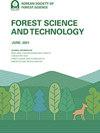Bees algorithm for Forest transportation planning optimization in Malaysia
IF 2.2
Q2 FORESTRY
引用次数: 2
Abstract
Abstract Algorithm is widely used in various areas due to its ability to solve classes of problems. Due to multiple objectives to be met and varied algorithm application in this digital era, addressing the problem-solving optimization in a more efficient and effective way has become more reasonable. Forest transportation planning is one of the most expensive activities in timber harvesting and can be optimized through algorithm application. Forest transportation planning is a vital component of timber harvesting activities. Inappropriate planning may raise the overall costs of harvesting activities. This paper aims to give an overview of several algorithm application in optimizing the forest transportation planning problem and give an insightful information regarding the relationships between algorithm and the integration of transportation system characteristics and variables. Examples of algorithm that are finding their way to the forest transportation planning problem include Genetic Algorithm (GA), Particle Swarm Optimization (PSO) algorithm, Ant Colony Optimization (ACO) algorithm, Simulated Annealing (SA) algorithm and Tabu Search (TS) algorithm. Although no literature was found regarding forest transportation planning problem optimization with regards to Bees Algorithm (BA), rules set for several transportation problem evidenced from literature search seems to be applicable to forestry. Generally, in this paper, the BA has been given focus for forest transportation planning problem optimization as a potential algorithm to overcome the challenges of environmental degradation and efficiency of timber extraction used, as well as its accuracy and less processing time for problem-solving.马来西亚森林交通规划优化的蜜蜂算法
摘要算法由于具有求解各类问题的能力而被广泛应用于各个领域。在这个数字时代,由于需要满足的目标多、算法应用多,以更高效、更有效的方式解决问题的优化变得更加合理。森林运输规划是木材采伐中成本最高的活动之一,可通过算法应用进行优化。森林运输规划是木材采伐活动的重要组成部分。不适当的计划可能会增加收获活动的总成本。本文概述了几种算法在优化森林交通规划问题中的应用,并对算法与交通系统特征和变量集成之间的关系进行了深入的探讨。用于森林交通规划问题的算法包括遗传算法(GA)、粒子群优化(PSO)算法、蚁群优化(ACO)算法、模拟退火(SA)算法和禁忌搜索(TS)算法。虽然没有发现关于蜜蜂算法(BA)的森林交通规划问题优化的文献,但从文献检索中得到的几个交通问题的规则集似乎适用于林业。总体而言,本文将BA作为克服环境退化和木材采掘效率挑战的潜在算法,以及解决问题的准确性和较少的处理时间,重点放在森林运输规划问题优化上。
本文章由计算机程序翻译,如有差异,请以英文原文为准。
求助全文
约1分钟内获得全文
求助全文

 求助内容:
求助内容: 应助结果提醒方式:
应助结果提醒方式:


